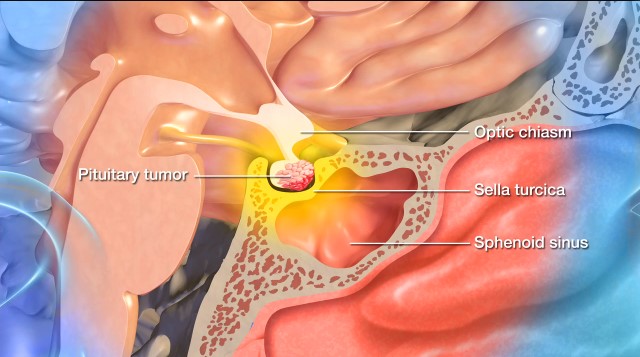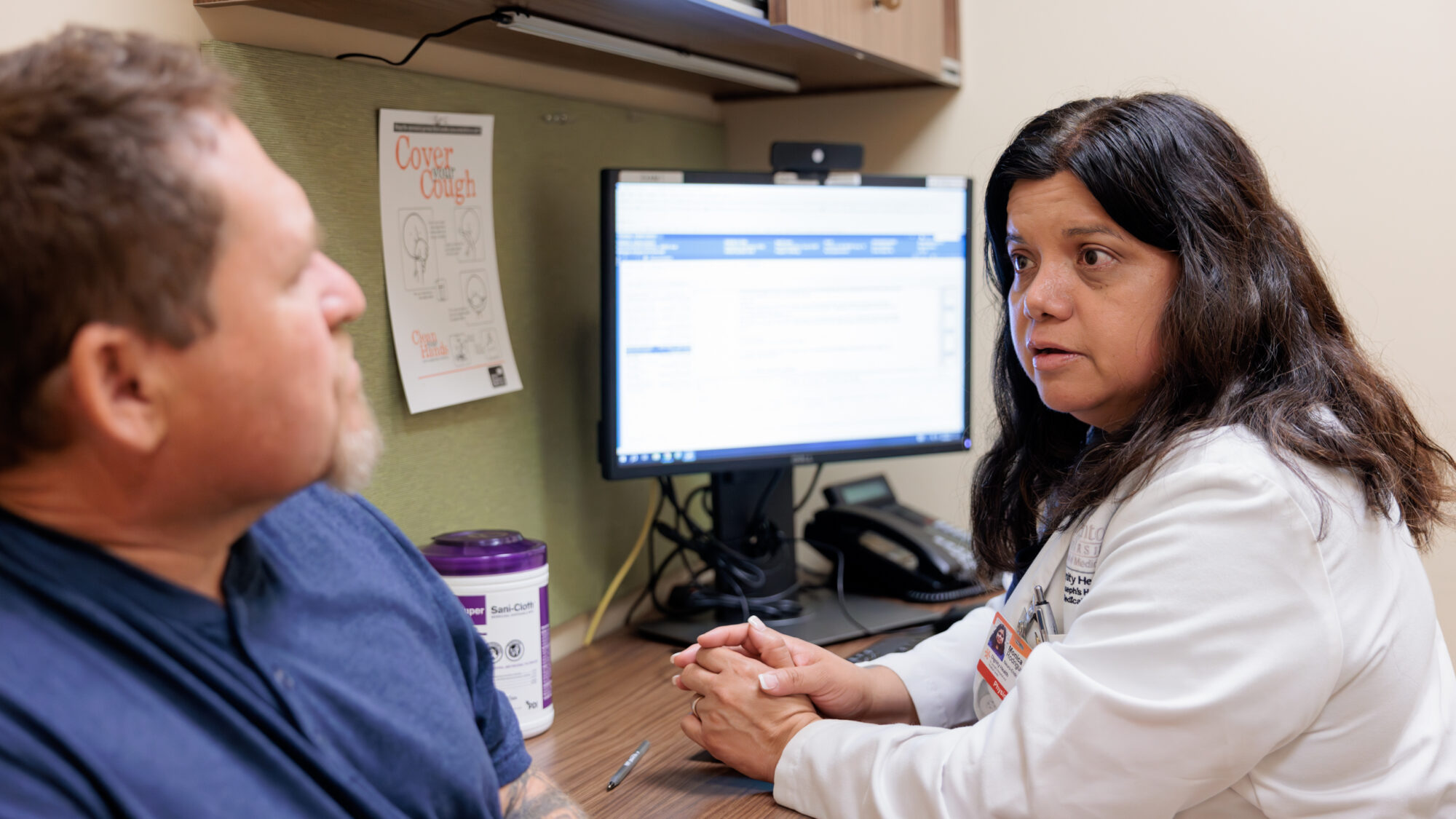
Adult Growth Hormone Insufficiency
Overview
Adult growth hormone deficiency (AGHD) is when the pituitary gland does not make enough growth hormone (GH). Growth hormone is one of eight crucial hormones the pituitary gland produces. It regulates metabolism, muscle and bone strength, blood sugars, and overall energy.
While GH is essential for childhood growth, it remains crucial well into adulthood for optimal heart function, bone health, muscle mass, and the ability to process protein, carbohydrates, and fat. When your body doesn’t produce enough GH, fatigue, reduced muscle strength, increased body fat, and decreased bone density can occur.

What causes adult growth hormone deficiency (AGHD)?
The most common causes of AGHD include:
- Pituitary Tumors: Tumors can interfere with the pituitary’s ability to produce hormones, including growth hormone.
- Pituitary Surgery, Brain Tumor Surgery, or Radiation: These treatments for pituitary tumors or other conditions can damage the pituitary gland, which can trigger AGHD.
- Head Trauma: Trauma to the head and brain can affect the pituitary gland, causing a reduction in growth hormone.
- Genetic Conditions: Some disorders present from birth, known as congenital disorders, can result in AGHD later in life.
In rare cases, infections, inflammatory conditions, or vascular damage to the pituitary gland can cause AGHD. In other cases, the cause of AGHD remains unknown.

Symptoms of Adult Growth Hormone Deficiency (AGHD)
Symptoms of adult growth hormone deficiency can vary, with fatigue, low energy, and weight gain being the most common.
If you or someone you know has AGHD, you may experience a combination of the following symptoms:
- Increased Body Fat: Since GH plays a key role in your body composition and metabolism, a deficiency can lead to more body fat, especially around your abdomen.
- Reduced Muscle Mass and Strength: Inadequate GH makes it harder to retain muscle mass, and a reduced capacity for exercise makes physical activity, including strength-building exercises, more difficult.
- Decreased Bone Density: Low levels of GH can lead to reduced bone density, which raises your risk of osteoporosis.
- Fatigue and Low Energy Levels: A GH deficiency causes decreasing physical and mental energy levels.
- High Cholesterol Levels: With insufficient GH, your overall risk of heart disease increases due to LDL—the “bad cholesterol”—rising while HDL—the “good cholesterol”—decreases.
- Dry Skin and Thinning Hair: Due to slowed cell regeneration, drier skin and thinning hair often occur.
- Poor Circulation: Insufficient GH means less nitric oxide, a molecule that helps blood vessels relax and widen. This, in turn, causes narrower blood vessels, which results in reduced blood flow.
- Reduced Blood Vessel Function: Without GH maintaining the elasticity of blood vessels, arteries become stiffer and less responsive to changes in blood pressure, which increases your risk of atherosclerosis, or a hardening of the arteries.
- Insulin Resistance: Inadequate GH can cause insulin resistance, which increases the risk of developing diabetes.
- Depression and Anxiety, or Mood Swings: Because GH affects brain function and mood, depression, anxiety, or more noticeable mood swings can occur.
- Cognitive Issues: This can look like having trouble concentrating or experiencing memory problems.
If you or someone you know is experiencing persistent fatigue and unexplained weight gain paired with additional symptoms outlined above, it’s essential to reach out to a healthcare provider for an evaluation. Remember, the presence of these symptoms alone doesn’t mean you have AGHD—a thorough evaluation by a healthcare professional with appropriate testing is required to confirm the diagnosis.
Adult Growth Hormone Deficiency (AGHD) Diagnosis
Diagnosing adult growth hormone deficiency (AGHD) requires a combination of evaluations, blood tests, and stimulation tests to measure growth hormone (GH) levels.
The doctors often use the following exams and imaging tests when diagnosing AGHD:
- Physical Exam: First, your healthcare provider will ask about your symptoms, overall health, and previous medical conditions. Next, they’ll complete an examination to assess physical characteristics like height and body composition, specific checks for changes in muscle mass or skin texture, and an exam to assess neurological function, including reflexes, coordination, strength, and sensation.
- IGF-1 Blood Test: While GH levels fluctuate throughout the day, a predictable way to track GH is by measuring IGF-1 levels. Low IGF-1 can indicate AGHD, but it does not confirm the condition, which is why this blood test can be used as an initial screening tool and is often followed by a GH stimulation test like the insulin tolerance test (ITT) or the glucagon stimulation test (GST).
- Insulin Tolerance Test: Considered the gold standard test for detecting AGHD, this test measures your growth hormone response after inducing low blood sugar with insulin. During this test, your provider will inject insulin to lower your blood sugar level, then take blood samples to measure the amount of GH in your blood. When your body experiences low blood sugar, known as hypoglycemia, it releases GH. However, if your blood tests reveal lower-than-normal levels of GH, AGHD is confirmed. It’s important to note that the insulin tolerance test isn’t suitable for everyone, and isn’t recommended for those with heart disease or epilepsy.
- Glucagon stimulation test: A widely used alternative to the insulin tolerance test, this test involves injecting glucagon, a hormone that regulates blood sugar levels, to stimulate growth hormone release. Blood samples are taken regularly for up to three to four hours to measure GH levels. If GH levels do not increase normally, it can signify AGHD.
After a combination of these tests has been performed, a diagnosis can be made, and a treatment plan can be implemented.

Treatments for Adult Growth Hormone Deficiency (AGHD)
The primary treatment for AGHD is growth hormone replacement therapy (GHRT), which improves energy levels, body composition, and overall quality of life.
Growth hormone replacement therapy involves daily or weekly injections of recombinant human growth hormone (rhGH), or somatotropin, to restore normal hormone levels. It is given as a subcutaneous injection—an injection done just under the skin—typically one time per day or one time per week in the abdomen, thigh, or upper arm. Your doctor will monitor the dose of rhGH through IGF-1 levels in the blood to determine if more or less is needed and can be adjusted over time to avoid side effects.
Potential side effects of too much GHRT include:
- Muscle or joint pain
- Fluid retention and swelling in the hands and feet
- Carpal tunnel syndrome
- Pain and numbness in the hands and wrists
- Increased blood sugar levels
If any of these symptoms appear, your healthcare provider will lower the amount of rhGH being given.
The benefits of GHRT are multifold:
- It increases muscle mass and reduces body fat
- Improves energy levels and exercise capacity
- Strengthens bones and reduces the risk of osteoporosis
- Enhances mood and cognitive function
- Lowers cholesterol
- Improve heart health
Many people will experience significant benefits within a few months. Still, it can take six months and a year to see full effects.
Recombinant human growth hormone treatment is contraindicated in people who have cancer. For those who have diabetes, low doses of rhGH should be used to avoid aggravating the blood sugars.
For the long-term management of AGHD, IGF-1 levels, cholesterol levels, quality of life questionnaires, lipids, and heart health should be periodically monitored.
Common Questions
How common is adult growth hormone deficiency (AGHD)?
Adult growth hormone deficiency (AGHD) is relatively rare: It’s estimated that out of the 340,000,000 adults in the U.S., only 6,000 to 13,000 have AGHD.
Who experiences adult growth hormone deficiency (AGHD)?
Adult growth hormone deficiency affects males and females equally, but specific populations are at a higher risk. These include:
- People who have had pituitary tumors, pituitary surgery, or radiation therapy
- Those who have had trauma or injury to the brain, resulting in pituitary damage
- Individuals with genetic conditions like congenital growth hormone deficiency
Overall, the condition is more commonly diagnosed in individuals who have had pituitary tumors, surgery, or radiation therapy. Because the name GH suggests that the hormone is only for growth purposes, the condition is often misunderstood as only occurring in children. Furthermore, the condition is underdiagnosed because its symptoms—fatigue, weight gain, and low energy—are frequently confused with the normal aging process or other conditions.
It is also imperative for your doctor to definitively confirm the diagnosis of AGHD before starting rhGH treatment, as rhGH treatment should never be used for anti-aging and sporting enhancement reasons.
What is the prognosis for those with AGHD?
With adequate treatment, people with AGHD generally have a good prognosis. However, the severity of the GH deficiency and the timeliness of the diagnosis are essential factors.
With GHRT, significant improvements in energy levels, muscle mass, bone density, and quality of life are frequently experienced. GHRT can also help reduce the risk of cardiovascular risk, as well as improve mental clarity and mood.
Long-term management with regular monitoring of GH levels and metabolic health can result in a normal life expectancy. When left untreated, AGHD can lead to long-term complications, including increased body fat, muscle loss, decreased bone density, osteoporosis, and an elevated risk of heart disease and diabetes.
Can AGHD be prevented?
Most cases of AGHD are not preventable, except for those caused by head injuries.



